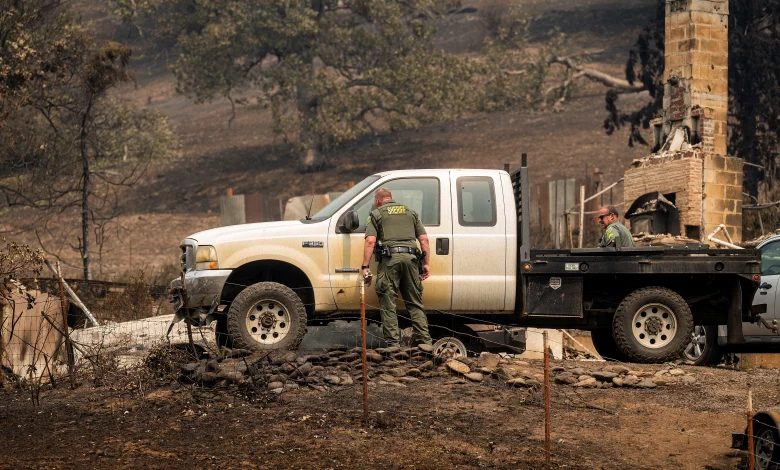Washington town evacuated, some homes burned in wildfire

LIND, Wash. – A small town in Washington state was evacuated due to a fast-moving fire that burned a half-dozen homes, as crews in California made progress against the state’s deadliest and largest wildfire of the year.
In Washington, the Adams County Sheriff’s Office said on Facebook early Thursday afternoon that residents of Lind needed to flee due to the encroaching flames.
“At this time all residents of the town of Lind need to evacuate immediately,” the sheriff’s office said in the post.
Later Thursday, Sheriff Dale Wagner said six homes had burned as well as eight other structures. With the help of state and local resources, Wagner said the fire was starting to calm down and by 8 p.m. all evacuation orders had been lifted.
“They will be fighting it through the night to make sure it doesn’t flare up anymore or get worse,” he said, adding that firefighters were dealing with high heat and windy conditions.
He said one firefighter suffered smoke inhalation and was flown to Spokane for treatment.
Lind is a community of about 500 people approximately 75 miles (121 kilometers) southwest of Spokane.
The State Fire Marshal’s office said the blaze had burned through about 3.9 square miles (10.1 square kilometers). Homes, infrastructure and crops were threatened. The cause of the fire was under investigation.
Meanwhile, in California, forecasters warned Thursday that spiking temperatures and plunging humidity levels could create conditions for further wildfire growth.
California and much of the rest of the West is in drought and wildfire danger is high, with the historically worst of the fire season still to come. Fires are burning throughout the region.
After five days of no containment, the McKinney Fire in California’s Siskiyou County near the Oregon border was 10% surrounded by Thursday. Bulldozers and hand crews were making progress carving firebreaks around much of the rest of the blaze, fire officials said.
At the fire’s southeastern corner, evacuation orders for sections of Yreka, home to about 7,800 people, were downgraded to warnings, allowing residents to return home but with a caution that the situation remained dangerous.
About 1,300 people remained under evacuation orders, officials said at a community meeting Wednesday evening.
The fire didn’t advance much at midweek, following several days of brief but heavy rain from thunderstorms that provided cloudy, damp weather. But as the clouds clear and humidity levels drops in the coming days, the fire could roar again, authorities warned.
“This is a sleeping giant right now,” said Darryl Laws, a unified incident commander on the blaze.
Weekend temperatures could reach triple digits as the region dries out again, said meteorologist Brian Nieuwenhuis with the National Weather Service office in Medford, Oregon.
The blaze broke out July 29 and has charred nearly 92 square miles (238 square kilometers) of forestland, left tinder-dry by drought. More than 100 homes and other buildings have burned and four bodies have been found, including two in a burned car in a driveway.
The fire was driven at first by fierce winds ahead of a thunderstorm cell. More storms earlier this week proved a mixed blessing. A drenching rain Tuesday dumped up to 3 inches (7.6 cm) on some eastern sections of the blaze but most of the fire area got next to nothing, said Dennis Burns, a fire behavior analyst.
The latest storm also brought concerns about possible river flooding and mudslides. A private contractor in a pickup truck who was helping the firefighting effort was hurt when a bridge gave out and washed away the vehicle, Kreider said. The contractor’s injuries were not life-threatening.
The progress against the flames came too late for many people in the scenic hamlet of Klamath River, which was home to about 200 people before the fire reduced many of the homes to ashes, along with the post office, community center and other buildings.
Scientists say climate change has made the West warmer and drier over the last three decades and will continue to make weather more extreme and wildfires more frequent and destructive. California has seen its largest, most destructive and deadliest wildfires in the last five years.
In northwestern Montana, a fire that has destroyed at least four homes and forced the evacuation of about 150 residences west of Flathead Lake continued to be pushed north by winds on Wednesday, fire officials said.
The Moose Fire in Idaho has burned more than 85 square miles (220 square km) in the Salmon-Challis National Forest while threatening homes, mining operations and fisheries near the town of Salmon.
And a wildfire in northwestern Nebraska led to evacuations and destroyed or damaged several homes near the small city of Gering.




